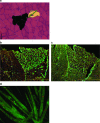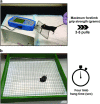Assessment of muscle mass and strength in mice
- PMID: 26331011
- PMCID: PMC4549925
- DOI: 10.1038/bonekey.2015.101
Assessment of muscle mass and strength in mice
Abstract
Muscle weakness is an important phenotype of many diseases that is linked to impaired locomotion and increased mortality. The force that a muscle can generate is determined predominantly by muscle size, fiber type and the excitation-contraction coupling process. Here we describe methods for the histological assessment of whole muscle to determine fiber cross-sectional area and fiber type, determination of changes in myocyte size using C2C12 cells, in vivo functional tests and measurement of contractility in dissected whole muscles. The extensor digitorum longus and soleus muscles are ideally suited for whole-muscle contractility, and dissection of these muscles is described.
Conflict of interest statement
The authors declare no conflict of interest.
Figures



References
-
- Bonetto A, Penna F, Minero VG, Reffo P, Bonelli G, Baccino FM et al.. Deacetylase inhibitors modulate the myostatin/follistatin axis without improving cachexia in tumor-bearing mice. Curr Cancer Drug Targets 2009; 9: 608–616. - PubMed
Grants and funding
LinkOut - more resources
Full Text Sources
Other Literature Sources
